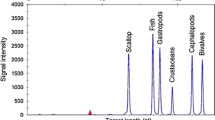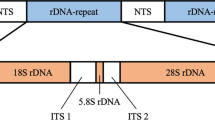Abstract
Fish are a common cause of allergic reactions associated with food consumption, with parvalbumin being the major allergenic protein. Some fish-hypersensitive patients tolerate some fish species while being allergic to others. Reliable detection methods for allergenic fish species in foods are necessary to ensure compliance with food allergen labeling guidelines to protect fish-allergic consumers. The objective of this project was to develop a multi-analyte detection method for the presence of fish in food. Therefore, conserved parvalbumin exon sequences were utilized for the design of universal PCR primers amplifying intron DNA and small regions of exons flanking the enclosed intron from even very distantly related fish species. An assay for the identification of eight fish species was developed using xMAP™ technology with probes targeting species-specific parvalbumin intron regions. Additionally, a universal fish probe was designed targeting a highly conserved exon region located between the intron and the reverse primer region. The universal fish assay showed no cross-reactivity with other species, such as beef, pork, lamb, chicken, turkey, and shrimp. Importantly, with the exception of one notable case with fish in the same subfamily, species-specific detection showed no cross-reactivity with other fish species. Limits of detection for these eight species were experimentally estimated to range from 0.01% to 0.04%, with potential to increase the detection sensitivity. This report introduces a newly developed method for the multiplex identification of at least eight allergenic fish species in food, which could conceivably be extended to detect up to 100 species simultaneously in one sample.

Schematic overview of the xMAP™ assay. Amine-modified capture oligonucleotides were covalently coupled to color-coded MagPlex™-C magnetic carboxylated microspheres (Luminex Corporation, TX, USA) using a carbodiimide coupling method described by Fulton et al. [25]. Parvalbuminencoding DNA was amplified with real-time PCR, whereas one of the primers was labeled with biotin. Biotin-labeled DNA strands were hybridized to their corresponding capture oligonucleotides. The fluorophor streptavidin–phycoerythrin (SAPE) was added and bound to the biotin molecules. Reaction tubes containing the magnetic microspheres were put on a magnet, unbound oligonucleotides and SAPE was removed by washing. The reaction mixture was analyzed on the BioPlex 200 analyzer (BioRad, CA, USA). Microspheres were interrogated individually in a rapidly flowing fluid stream as they passed by two separate lasers. A red diode laser excited two fluorochromes contained within the colorcoded microspheres and a green laser excited the reporter fluorochrome (SAPE) bound to the microsphere surface. High-speed digital signal processing classified the microsphere based on its spectral address and quantified the reaction on the surface




Similar content being viewed by others
References
Bousquet J, Bjorksten B, Bruijnzeel-Koomen C, Huggett A, Ortolani C, Warner JO, Smith M (1998) Scientific criteria and the selection of allergenic foods for product labeling. Allergy 53:3–21
Hefle SL, Nordlee JA, Taylor SL (1996) Allergenic foods. Crit Rev Food Sci Nutr 36:69–89
Sicherer SH (2001) Clinical implications of cross-reactive food allergens. J Allergy Clin Immunol 108:881–890
Swoboda I, Bugajska-Schretter A, Verdino P, Keller W, Sperr WR, Valent P, Valenta R, Spitzauer S (2002) Recombinant carp parvalbumin, the major cross-reactive fish allergen: a tool for diagnosis and therapy of fish allergy. J Immunol 57:4576–4584
Sapmson HA (1999) Food allergy. Part 1: immunopathogenesis and clinical disorders. J Allergy Clin Immunol 103:717–728
Pascual C, Esteban MM, Crespo JF (1992) Fish allergy: evaluation of the importance of cross-reactivity. J Pediatr 121:29–34
O’Neil C, Helbling AA, Lehrer SB (1993) Allergic reactions to fish. Clin Rev Allergy 11:183–200
Aas K, Jebsen JW (1967) Studies of hypersensitivity to fish: partial purification and crystallisation of a major allergenic component of cod. Int Arch Allergy 32:1–20
Coffee CJ, Bradshaw RA (1973) Carp muscle calcium-binding protein. I. Characterisation of the tryptic peptides and the complete amino acid sequence. J Biol Chem 248:3305–3312
Gerday C (1982) Soluble calcium-binding proteins from fish and invertebrate muscle. Mol Physiol 2:63–87
Bugajska-Schretter A, Grote M, Vangelista L, Valent P, Sperr WR, Rumpold H, Pastore A, Reichelt R, Valenta R, Spitzauer S (2000) Purification, biochemical and immunological characterization of a major food allergen: different immunoglobulin E recognition of the apo- and calcium-bound forms of carp parvalbumin. Gut 46:661–669
de Martino M, Novembre E, Galli L, de Marco A, Botarelli P, Marano E, Vierucci A (1990) Allergy to different fish species in cod-allergic children: in vivo and in vitro studies. J Allergy Clin Immunol 86:909–914
Hansen TK, Bindslev-Jensen C, Stahl Skov P, Poulsen LK (1997) Codfish allergy in adults: IgE cross reactivity among fish species. Ann Allerg Asthma Im 78:187–194
Hilger C, Thill L, Grigioni F, Lehners C, Falagiani P, Ferrara A, Romano C, Stevens W, Hentges F (2004) IgE antibodies of fish allergic patients cross-react with frog parvalbumin. Allergy 59:653–660
Helbling A, Haydel R Jr, McCants ML, Musman JJ, El-Dahr J, Lehrer SB (1999) Fish allergy: is cross-reactivity among fish species relevant? Double blind placebo-controlled food challenge studies of fish allergic adults. Ann Allergy Asthma Immunol 83:517–523
Van Do T, Elsayed S, Florvaag E, Hordvik I, Endresen C (2005) Allergy to fish parvalbumins: studies on the cross-reactivity of allergens from 9 commonly consumed fish. J Allergy Clin Immunol 116:1314–1320
Rehbein H, Kress G (2005) Detection of short mRNA sequences in fishery products. Dt Lebensmittel-Rdsch 101:333–337
Lindstrom CD, Van Do T, Hordvik I, Endresen C, Elsayed S (1996) Cloning of two distinct cDNAs encoding parvalbumin, the major allergen of Atlantic salmon (Salmo salar). Scand J Immunol 44:335–344
Van Do T, Hordvik I, Endresen C, Elsayed S (2003) The major allergen (parvalbumin) of codfish is encoded by at least two isotopic genes: cDNA cloning, expression and antibody binding of the recombinant allergens. Mol Immunol 39:595–602
Sun M, Liang C, Gao H, Lin C, Deng M (2009) Detection of parvalbumin, a common fish allergen gene in food, by real-time polymerase chain reaction. J AOAC Int 92:234–240
Friedberg F (2005) Parvalbumin isoforms in zebrafish. Mol Biol Rep 32:167–175
Chen L, Hefle SL, Taylor SL, Swoboda I, Goodman RE (2006) Detecting fish parvalbumin with commercial mouse monoclonal anti-frog parvalbumin IgG. J Agric Food Chem 54:5577–5582
Girija N, Rehbein H (1988) Comparison of parvalbumin patterns from different fish species by isoelectric focusing of muscle extracts. Comp Biochem Physiol 91B:723–728
Dunbar SA (2006) Applications of Luminex® xMAP™ technology for rapid, high-throughput multiplexed nucleic acid detection. Clin Chim Acta 363:71–82
Fulton RJ, McDade RL, Smith PL, Kienker LJ, Kettman JR Jr (1997) Advanced multiplexed analysis with the FlowMetrix™ system. Clin Chem 43:1749–1756
Dunbar SA, Vander Zee CA, Oliver KG, Karem KL, Jacobson JW (2003) Quantitative, multiplexed detection of bacterial pathogens: DNA and protein applications of the Luminex LabMAP™ system. J Microbiol Meth 53:245–252
Bernhisel-Broadbent J, Scanlon SM, Sampson HA (1992) Fish hypersensitivity, I: in vitro and oral challenge results in fish-allergic patients. J Allergy Clin Immunol 89:730–737
James JM, Helm RM, Burks AW, Lehrer SB (1997) Comparison of pediatric and adult IgE antibody binding to fish proteins. Ann Allergy Asthma Immunol 79:131–137
Yamada S, Nolte H, Zychlinsky E (1999) Identification and characterization of allergens in two species of tuna fish. Ann Allergy Asthma Immunol 82:395–400
Lim DL, Neo KH, Goh DL, Shek LP, Lee BW (2005) Missing parvalbumin: implications in diagnostic testing for tuna allergy. J Allergy Clin Immunol 115:874–875
Oakley TH, Phillips RB (1999) Phylogeny of Salmonine fishes based on growth hormone introns: Atlantic (Salmo) and Pacific (Oncorhynchus) salmon are not sister taxa. Mol Phylogenet Evol 11:381–393
Taylor SL, Hefle SL, Bindslev-Jensen C, Bock SA, Burks AW Jr, Christie L, Hill DJ, Host A, Hourihane JO, Lack G, Metcalfe DD, Moneret-Vautrin DA, Vadas PA, Rance F, Skrypec DJ, Trautman TA, Yman IM, Zeiger RS (2002) Factors affecting the determination of threshold doses for allergenic foods: how much is too much? J Allergy Clin Immunol 109:24–30
Park HG, Song JY, Park KH, Kim MK (2006) Fluorescence-based assay formats and signal amplification strategies for DNA microarray analysis. Chem Eng Sci 61:954–965
Taton TA, Mirkin CA, Letsinger RL (2000) Scanometric DNA array detection with nanoparticle probes. Science 289:1757–1760
Acknowledgments
Gratitude is expressed to Jonathan Deeds, Ph.D. (FDA) for providing the authenticated fish samples. Appreciation is also expressed to Eric A. E. Garber, Ph.D. (FDA) and Steven R. Monday, Ph.D. (FDA) for guidance and critical reading of this work.
Author information
Authors and Affiliations
Corresponding author
Rights and permissions
About this article
Cite this article
Hildebrandt, S. Multiplexed identification of different fish species by detection of parvalbumin, a common fish allergen gene: a DNA application of multi-analyte profiling (xMAP™) technology. Anal Bioanal Chem 397, 1787–1796 (2010). https://doi.org/10.1007/s00216-010-3760-2
Received:
Revised:
Accepted:
Published:
Issue Date:
DOI: https://doi.org/10.1007/s00216-010-3760-2




